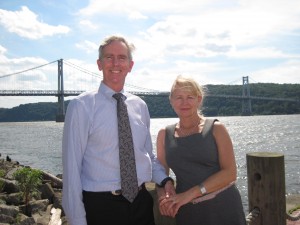
Your trigonometry could be failing you. Ditto your recollections of Venn diagrams. But merely by participating in life, you cannot escape the drumbeat of one old-school lesson: The whole is greater than the sum of its parts. The concept of power in union works for Rayon and for marching armies. “Synergy” ”“ a longtime biochemistry data point ”“ is de rigueur in economic discourse.
Formidability from the union of two persons can be tougher to quantify. Often his and her professional interests orbit independently. The pillow talk between the attorney and her restaurateur husband might understandably stray from policy of state. Yet they know in two they have a formidable power and they use it: to ply the currents and shoals of life.
Red Hook’s Tara and Ned Sullivan are different. They display a formidability that is evident beyond their marriage and a glorious stretch of New York state is cleaner and better connected for it.
His ”™n”™ her Sullivan accomplishments come in an avalanche. He helped clean up Love Canal and organized the state”™s initial hazardous waste pushback under Gov. Mario Cuomo. She fought successfully for the removal of 100 miles of toxic pipe from beneath Woodstock. He was Maine’s environmental commissioner. She was a policy analyst for Maine U.S. Rep. Tom Allen. She advised Gov. Eliot Spitzer on solid waste. He was just named to Gov. Andrew Cuomo”™s Hudson Valley regional economic council. She directed the state’s yearlong quadricentennial celebration in 2009. He now heads Poughkeepsie-based Scenic Hudson. She is deputy executive director of the New York State Bridge Authority.
Scenic Hudson is a national-caliber player on matters of environment, beginning with its successful defense of Storm King Mountain against a power plant in 1963. In Ned, who was also New York’s deputy environmental commissioner for eight years, it found in 1999 a perfect match of activism (even a graduate degree in forestry) and legislative savvy.
Scenic Hudson has created or enhanced 50 parks, preserves and historic sites and protected 6,000 acres of the region”™s vistas and valleys. Scenic Hudson since 2007 has partnered with 16 land-preservation groups in a program called “Saving the Land that Matters Most” that has protected 26 critical valley parcels. Via a never-ending stream of programs and rambles, it invites the public to enjoy its own backyard.
Tara has been navigating government”™s corridors since the 1980s and is now deputy executive director of the New York State Bridge Authority. In that capacity, she views the bridges as unifiers of a region otherwise rent down the middle by a river. The urge to wed east and west banks was always there as countless ferries proved. The river bottom bears a bleaker history of yearning to unite, littered with tin lizzies that pushed the season on the river”™s infamous ice roads. Six million vehicles crossed Bear Mountain Bridge in 2007, up from 483,000 in the mid-1940s.
Tara serves under bridge authority Executive Director Joseph Ruggiero. He and the agency, she said, “are so proud of those bridges. In all their years of operation” ”“Bear Mountain dates to 1924 and has been under authority control since 1940 ”“ “the bridges have never had a red flag. And one dollar. You can’t beat it.” She admires them, as well, saying, “They”™re all unique and they”™re all beautiful.” Flashing her diplomatic side, the mother of two daughters, 27 and 14, said, “I love them all equally.”
The authority now counts six bridges under its stewardship (north to south): Rip Van Winkle, Kingston-Rhinecliff, Mid-Hudson, Newburgh-Beacon and Bear Mountain. Its sixth bridge is Walkway Over the Hudson, which the authority manages from its base to just beneath the walking deck. The deck is operated by the state Department of Parks, Recreation and Historic Preservation. The walkway attracted nearly a million visitors its first year when one-third that number were expected.
“The walkway has already been a huge success,” she said. “It has pumped a ton of tax revenue into valley coffers. The tourism industry is one of the big economic engines of the valley, $4 (million) to $5 million in revenue in the last year.”
Scenic Hudson provided $1 million toward the walkway “at a critical moment in the fundraising,” according to Ned. He credited also “those who had the vision and the persistence to make it happen,” and singled out the Dyson Foundation and grassroots activism for taking the lead.
The Sullivans spoke in Poughkeepsie”™s Waryas Park with the Mid-Hudson Bridge and the just-dedicated Franny Reese State Park as a backdrop. At the bridge”™s west terminus, a new staircase accesses the 251-acre park”™s trailhead. The 212-foot-high walkway, too, links with hiking trails. Ned believes these quality-of-life assets are getting noticed.
“There has been a shift. People realize it”™s no longer the environment versus the economy. They go hand in hand; they support each other. There have been a number of national studies involving corporate CEOs and when they consider setting up a corporate headquarters or manufacturing facility, they consider quality of life ”“ beauty of the region, access to public parks ”“ to be top priorities. More important even than good schools and affordable housing. It”™s really a key issue in where to locate their businesses.”
Tara would tell those same CEOs, “At a dollar, you can go from one side of the river to the other without having to think about it. They are among the least-expensive bridges in the country. They”™re very safe, with a highly maintained structural integrity. We”™re very proud of that.”

















